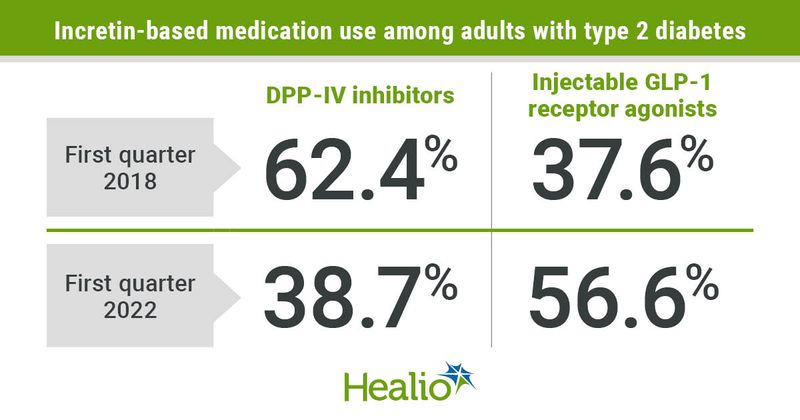More adults with type 2 diabetes now using GLP-1s instead of DPP-IV inhibitors
Click Here to Manage Email Alerts
Key takeaways:
- Most adults with type 2 diabetes receiving an incretin-based drug in 2022 used a GLP-1 receptor agonist.
- DPP-IV inhibitor use declined from 62.4% in 2018 to 37.6% in 2022.
Of adults with type 2 diabetes who used an incretin-based medication, the majority received an injectable GLP-1 receptor agonist in the first quarter of 2022, according to study findings.
In data that will be presented at the European Association for the Study of Diabetes annual meeting, researchers found large changes in incretin-based medication use among adults with type 2 diabetes in the U.S. from 2018 to 2022. Although DPP-IV inhibitors were used by more than 60% of incretin-based medication users in 2018, that percentage dropped to 38.7% by 2022. During that same period, the use of injectable GLP-1 receptor agonists increased from 37.6% to 56.6%.

“From a clinical point of view, there is surging demand for both injectable and, more recently, oral semaglutide around the world for weight loss,” Alexander Kutz, MD, MPH, MSc, internist and endocrinologist in the division of pharmacoepidemiology, department of medicine at Brigham and Women`s Hospital and Harvard University, told Healio. “It is likely that oral semaglutide will become one of the leading drugs among oral users of incretin-based medications, but sitagliptin and other DPP-IV inhibitors may be still preferred in older and multimorbid patients at higher risk of frailty; for example, in the setting of nursing homes.”
Researchers conducted a retrospective cohort study of data from the Optum Clinformatics Data Mart on 1,065,592 adults with type 2 diabetes who used incretin-based medications from the first quarter of 2018 to the first quarter of 2022. Researchers analyzed the percentage of adults using DPP-IV inhibitors, injectable GLP-1 receptor agonists and oral semaglutide (Rybelsus, Novo Nordisk) in each quarter. Use was stratified by cardiovascular disease and chronic kidney disease.
In the first quarter of 2018, 62.4% of adults were using DPP-IV inhibitors compared with 37.6% using a GLP-1. By the first quarter of 2022, DPP-IV inhibitor use declined to 38.7% while GLP-1 use increased to 56.6%. Oral semaglutide use began in the fourth quarter of 2019 and increased to 4.7% by the first quarter of 2022.
Among those using GLP-1 receptor agonists, the use of liraglutide (Saxenda, Novo Nordisk) declined from 44.2% in the first quarter of 2018 to 10% in the first quarter of 2022, and exenatide (Byetta, AstraZeneca) use dropped from 15% in the first quarter of 2018 to 3.8% in the first quarter of 2022. Injectable semaglutide (Ozempic, Novo Nordisk) use increased from 0% in 2018 to 33.7% in 2022, dulaglutide (Trulicity, Eli Lilly) use increased from 35.2% in 2018 to 42.1% in 2022 and oral semaglutide use to 7.7% of all GLP-1 users in 2022.
Among oral medication users, sitagliptin (Januvia, Merck) was the most commonly prescribed agent during the entire study period, though its use dropped from 62% in the first quarter of 2018 to 49.5% in the first quarter of 2022. Of all oral medication users, 23.1% were receiving oral semaglutide by the first quarter of 2022. The use of linagliptin (Tradjenta, Boehringer Ingelheim/Eli Lilly) and saxagliptin (Onglyza, AstraZeneca) both decreased during the course of the study.
Adults initiating GLP-1 receptor agonists were more likely to have obesity and be seen by an endocrinologist, and less likely to have CKD or dementia compared with those initiating a DPP-IV inhibitor.
Kutz said new medications such as tirzepatide (Mounjaro, Eli Lilly) may lead to further prescribing changes for adults with type 2 diabetes. However, he added more evidence on tirzepatide is needed before its use begins to increase.
“We definitively need more cardiovascular evidence on tirzepatide before adopting its widespread use in patients diagnosed with type 2 diabetes and overweight or obesity,” Kutz said. “This is important as unanswered questions remain about cost-effectiveness, risk-benefit balance in lean people with type 2 diabetes and the elderly, as well as CV benefits in the primary and secondary prevention setting.”

